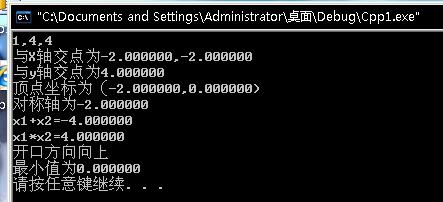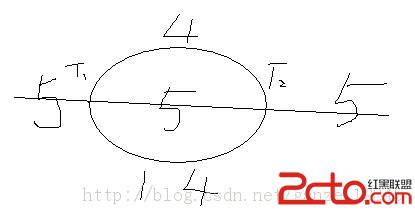hdu4085 Peach Blossom Spring 斯坦纳树,状态dp
(1)集合中元素表示(1<<i), i从0开始(2)注意dp[i][ss] = min(dp[i][ss], dp[i][rr | s[i]] + dp[i][(ss ^ rr) | s[i]]);,后面的要 |s[i],保证状态的正确
(3)INF初始化CLR(dp, 0x3f)
(4)注意斯坦纳树状态理解,分层松弛的理解
参考:http://endlesscount.blog.163.com/blog/static/821197872012525113427573/
//#pragma warning (disable: 4786)
//#pragma comment (linker, "/STACK:16777216")
//HEAD
#include <cstdio>
#include <ctime>
#include <cstdlib>
#include <cstring>
#include <queue>
#include <string>
#include <set>
#include <stack>
#include <map>
#include <cmath>
#include <vector>
#include <iostream>
#include <algorithm>
using namespace std;
//LOOP
#define FE(i, a, b) for(int i = (a); i <= (b); ++i)
#define FED(i, b, a) for(int i = (b); i>= (a); --i)
#define REP(i, N) for(int i = 0; i < (N); ++i)
#define CLR(A,value) memset(A,value,sizeof(A))
//INPUT
#define RI(n) scanf("%d", &n)
#define RII(n, m) scanf("%d%d", &n, &m)
#define RIII(n, m, k) scanf("%d%d%d", &n, &m, &k)
#define RS(s) scanf("%s", s)
typedef long long LL;
const int INF = 0x3f3f3f3f;
const double eps = 1e-10;
const int MAXN = 1000010;
struct node{
int to, next, l;
};
int tol;
node adj[2010];
int head[55];
void init_adj()
{
tol = 0;
CLR(head, -1);
}
void add_edge(int x, int y, int ll)
{
adj[tol].to = y;
adj[tol].l = ll;
adj[tol].next = head[x];
head[x] = tol++;
}
int dp[55][1 << 11];
queue<int>q;
bool inq[55][1 << 11];
int d[1 << 11];
int s[55];
int n, m, k;
int cnt, ALL;
bool check(int ss)
{
int num = 0;
for (int i = 0; i < cnt; i++)
if (ss & (1 << i))
num += i < k ? 1 : -1;
if (!num) return 1;
return 0;
}
void spfa()
{
while (!q.empty())
{
int u = q.front(); q.pop();
int ui = u / 10000;
int uss = u % 10000;
inq[ui][uss] = 0;
for (int r = head[ui]; r != -1; r = adj[r].next)
{
int vi = adj[r].to;
int vss = uss | s[vi];
if (dp[vi][vss] > dp[ui][uss] + adj[r].l)
{
dp[vi][vss] = dp[ui][uss] + adj[r].l;
if (vss == uss && !inq[vi][vss]) /// 同层且不再队列中
{
inq[vi][vss] = 1;
q.push(vi * 10000 + vss);
}
}
}
}
}
void solve()
{
while (!q.empty()) q.pop();
CLR(inq, 0);
FE(ss, 0, ALL)
{
FE(i, 1, n)
{
for (int rr = ss & (ss - 1); rr; rr = (rr - 1) & ss)///ss
dp[i][ss] = min(dp[i][ss], dp[i][rr | s[i]] + dp[i][(ss ^ rr) | s[i]]);
if (dp[i][ss] < INF)
q.push(i * 10000 + ss), inq[i][ss] = 1;
}
spfa();
}
CLR(d, 0x3f);
FE(ss, 0, ALL) FE(j, 1, n)
d[ss] = min(d[ss], dp[j][ss]);
REP(ss, ALL + 1)
for(int rr = ss & (ss - 1); rr; rr = (rr - 1) & ss)
if (check(rr) && check(ss ^ rr))
d[ss] = min(d[ss], d[rr] + d[ss ^ rr]);
if (d[ALL] == INF) printf("No solution\n");
else printf("%d\n", d[ALL]);
}
void init()
{
int x, y, l;
init_adj();
RIII(n, m, k);
while (m--)
{
RIII(x, y, l);
add_edge(x, y, l);
add_edge(y, x, l);
}
cnt = 2 * k;
ALL = (1 << cnt) - 1;
CLR(s, 0);
CLR(dp, 0x3f);
FE(i, 1, k)///集合
{
s[i] = 1 << (i - 1);
dp[i][s[i]] = 0;
s[n - k + i] = 1 << (k + i - 1);
dp[n - k + i][s[n - k + i]] = 0;
}
}
int main ()
{
int T;
RI(T);
while (T--)
{
init();
solve();
}
return 0;
}
补充:软件开发 , C++ ,




